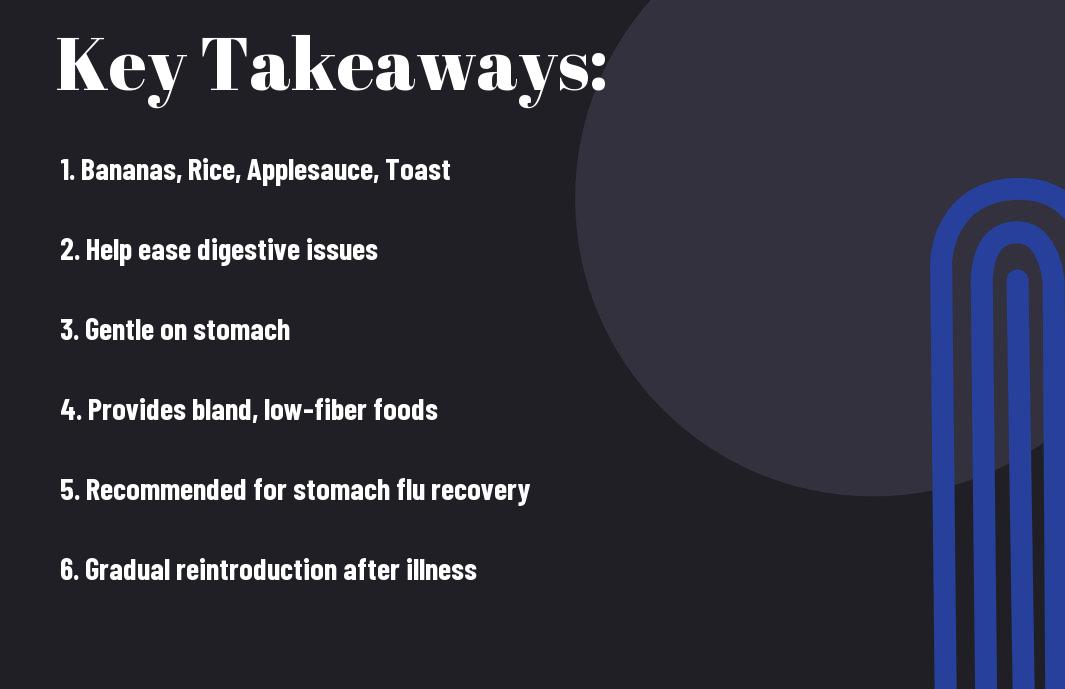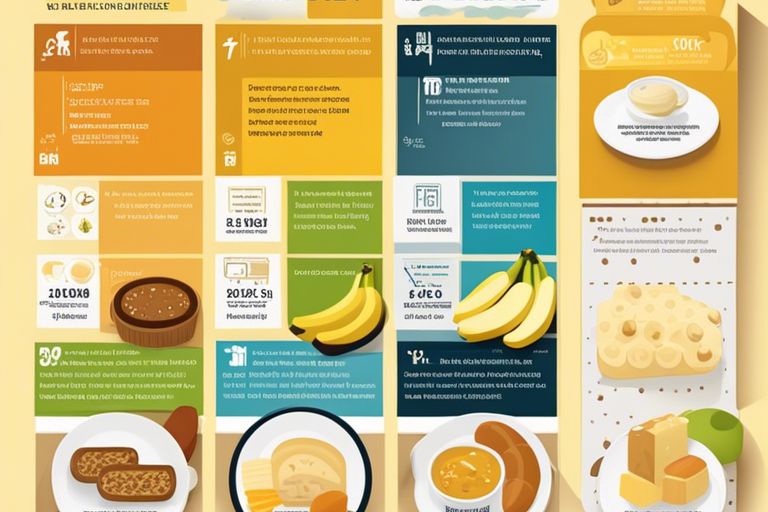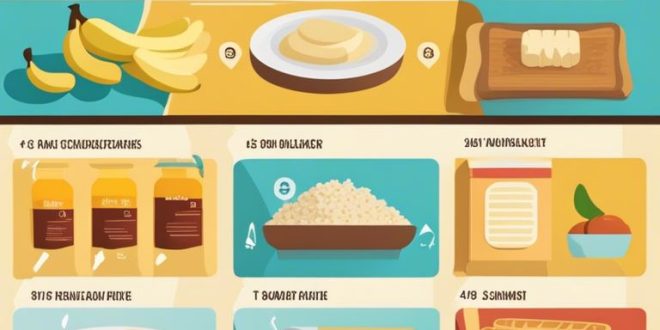It’s important to understand the significance of BRAT when following the BRAT diet for gastrointestinal issues. BRAT stands for bananas, rice, applesauce, and toast, which are the four bland and easily digestible foods that make up this diet. These foods can aid in soothing an upset stomach and are recommended for individuals recovering from gastrointestinal illnesses such as diarrhea or vomiting. By incorporating these simple yet effective foods into your diet, you can help alleviate discomfort and promote recovery.

Table of Contents
Understanding BRAT
Definition of BRAT
One of the most commonly recommended diets for easing digestive issues is the BRAT diet. BRAT stands for Bananas, Rice, Applesauce, and Toast. This bland diet is low in fiber, fat, and spices, making it gentle on the stomach and easy to digest.
Components of the BRAT Diet
With the BRAT diet, each component plays a specific role: Bananas provide potassium and help with bowel movements; Rice is a binding food that helps firm up stools; Applesauce is easy to digest and gentle on the stomach; Toast provides necessary carbohydrates for energy.
BRAT diet is commonly recommended for individuals experiencing gastrointestinal issues such as diarrhea, nausea, or vomiting. It helps in soothing the digestive system and providing crucial nutrients without aggravating the stomach.
Implementation of the BRAT Diet
While the BRAT diet may be familiar to many people, its implementation can vary based on individual needs and circumstances. To fully understand the ins and outs of the BRAT diet, it’s necessary to explore its uses, benefits, and alternatives. You can find more information on the BRAT Diet: Uses, Benefits, and Alternatives.
When to Use the BRAT Diet
Diet changes such as the BRAT diet can be beneficial for individuals experiencing gastrointestinal issues like diarrhea, nausea, or vomiting. The BRAT diet—consisting of bananas, rice, applesauce, and toast—may help soothe the stomach and provide easy-to-digest foods during times of digestive distress.
Guidelines for Following the BRAT Diet
When following the BRAT diet, it is necessary to keep in mind that this diet is low in fiber, protein, and fat. It is not a long-term solution, and it is crucial to introduce other foods gradually back into your diet to ensure you are receiving a well-rounded mix of nutrients. It is advisable to consult a healthcare professional for personalized recommendations tailored to your specific situation.
BRAT diets are best utilized for short periods (24-48 hours) to give the stomach a break and then slowly reintroduce a balanced diet for optimal nutrition and recovery.

Potential Benefits and Limitations
Benefits of the BRAT Diet for Digestive Issues
Unlike some other diets, the BRAT diet is specifically designed to be gentle on the stomach and intestines, making it ideal for individuals experiencing digestive issues such as diarrhea, nausea, and vomiting. The simple foods included in the BRAT diet – bananas, rice, applesauce, and toast – are easy to digest and can help soothe an irritated digestive system.
Limitations and Considerations
Limitations of the BRAT diet include its lack of vital nutrients and limited variety of foods, which may lead to nutritional deficiencies if followed for an extended period of time. It is important to consult a healthcare provider before starting the BRAT diet, especially for individuals with chronic health conditions, to ensure that all dietary needs are being met.
Although the BRAT diet can be beneficial for short-term relief of digestive issues, such as during bouts of diarrhea or stomach flu, it is not intended to be a long-term solution for overall nutrition. It is important to return to a balanced diet that includes a variety of fruits, vegetables, lean proteins, and whole grains once digestive symptoms have improved to ensure adequate nutrient intake and overall health.
Alternatives and Advances
Alternative Dietary Suggestions for Gastrointestinal Distress
For individuals experiencing gastrointestinal distress who may not find relief from the BRAT diet, alternative dietary suggestions could include incorporating easily digestible foods such as plain crackers, boiled potatoes, cooked carrots, and bananas. These foods are gentle on the stomach and can help alleviate symptoms like nausea, bloating, and diarrhea.
Advances in Dietary Recommendations for Digestive Health
Suggestions for advancements in dietary recommendations for digestive health include focusing on a diverse and balanced diet rich in fiber, fruits, vegetables, lean proteins, and whole grains. These dietary choices can support gut health, promote regular bowel movements, and provide necessary nutrients for overall well-being.
Healthy dietary patterns like the Mediterranean diet or the DASH diet have been associated with improved digestive health outcomes, including reducing the risk of gastrointestinal disorders such as irritable bowel syndrome and acid reflux. Consulting a healthcare provider or a registered dietitian can help individuals tailor their diet to optimize digestive health and overall wellness.
Final Words
As a reminder, BRAT in the BRAT diet stands for Bananas, Rice, Applesauce, and Toast. These bland and easily digestible foods can help soothe an upset stomach and aid in recovery from gastrointestinal issues. While the BRAT diet may be helpful for a short period of time, it is important to consult with a healthcare provider for a proper diagnosis and treatment plan for any ongoing gastrointestinal issues. Remember to stay hydrated and gradually reintroduce a balanced diet rich in nutrients once symptoms improve. Take care of your health and listen to your body’s needs for a speedy recovery.
FAQ
Q: What does BRAT stand for in the BRAT diet?
A: BRAT stands for Bananas, Rice, Applesauce, and Toast. These are the four bland and easily digestible foods recommended in the BRAT diet for managing gastrointestinal issues like diarrhea and upset stomach.
Q: Why are these specific foods included in the BRAT diet?
A: The foods included in the BRAT diet are low in fiber, fat, and spices, which can help reduce the frequency of bowel movements and provide relief to the digestive system. They also help in replenishing nutrients and electrolytes lost due to diarrhea.
Q: How long should I follow the BRAT diet?
A: The BRAT diet is not meant to be followed for an extended period of time. It is typically recommended to follow the diet for 24-48 hours until the symptoms improve. After that, it is important to gradually reintroduce a normal, balanced diet to ensure you are getting all the necessary nutrients.
 hqsportz Personal Website | Tell Information about Sport, Fashion And Health
hqsportz Personal Website | Tell Information about Sport, Fashion And Health



